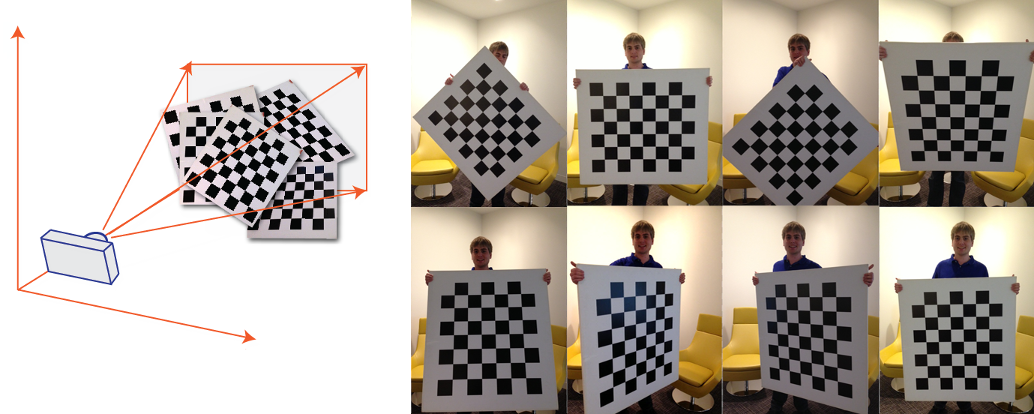카메라 보정을 위해 카메라를 준비하고 영상 캡처하기
다음 카메라 설정 팁과 영상 캡처하기 지침을 따르면 보정 결과에 문제가 생기는 것을 방지할 수 있습니다. 이 팁과 지침을 따르지 않거나 사용하는 보정 영상의 품질이 좋지 않으면 다음과 같은 보정 문제가 하나 이상 발생할 수 있습니다.
단일 카메라의 영상 왜곡 보정(image undistortion)이 올바르지 않음
스테레오 카메라의 영상 보정(image rectification)이 올바르지 않음
초점 거리, 주점, 왜곡 계수 등과 같은 카메라 파라미터의 추정이 부정확함
스테레오 카메라의 깊이 정보 추정이 부정확함
보정 영상은 동일평면상에 있지 않아야 합니다. 공간 평면당 하나의 보정 영상만 사용하십시오.
카메라 설정
다음 팁을 따라 카메라 보정을 위해 카메라를 설정합니다.
카메라의 자동 초점을 비활성화하여 고정 초점으로 영상을 캡처합니다. 활용 분야에 적합하게 카메라 초점을 설정합니다.
보정 패턴을 카메라로부터 적절한 거리에 배치하여 보정 패턴이 영상의 최소 20%를 차지하도록 합니다.
스테레오 카메라 쌍을 사용하여 영상을 캡처하는 경우 두 카메라 모두에서 패턴이 완전히 보이도록 서로 다른 방향으로 패턴을 배치합니다.
영상 간 확대/축소 설정을 변경하면 초점 거리가 변경된다는 점에 유의하십시오.
영상 캡처하기
더 높은 보정 정확도와 결과를 얻으려면, 보정 패턴이 포함된 영상을 최소 10~20개 사용하십시오. 보정기에는 최소 3개의 영상이 필요합니다. 압축되지 않은 영상이나 PNG와 같은 무손실 압축 형식 영상을 사용하십시오. 보정 정확도를 높이려면 다음과 같이 하십시오.
보정 패턴을 인쇄한 후 왜곡된 부분이 있지 않은지 확인하십시오. 보정 패턴 인쇄에 대한 자세한 내용은 지원되는 패턴 항목을 참조하십시오.
보정 패턴을 단단한 표면에 놓거나 부착하십시오.
보정 패턴을 둘러싸는 흰색 테두리가 있어야 합니다. 테두리는 적어도 패턴의 그리드 요소 하나만큼 커야 합니다. 흰색 테두리가 충분히 크지 않으면 특정 조명 조건에서 패턴이 제대로 검출되지 않을 수 있습니다.
패턴 영상을 카메라와 관심 객체 간의 거리와 대략적으로 같은 거리에서 캡처하십시오. 예를 들어, 2미터 거리에서 객체를 측정하려는 경우 패턴을 카메라에서 약 2미터 떨어진 곳에 둡니다.
패턴을 카메라 평면에 대해 45도 이하의 각도로 배치하십시오.

영상을 수정하지 마십시오. 예를 들어, 영상을 자르지 마십시오.
자동 초점을 사용하지 말고 영상 간 확대/축소 설정도 변경하지 마십시오.
카메라를 기준으로 여러 다른 방향으로 보정 패턴 영상을 캡처하십시오. 보정 패턴에 대한 자세한 내용은 보정 패턴 항목을 참조하십시오.
패턴의 영상을 다양하게 캡처하여 영상 프레임의 최대한 많은 부분이 포함될 수 있도록 하십시오. 렌즈 왜곡은 영상의 중심에서 방사형으로 증가하며, 영상 프레임 전체에서 항상 균일하지는 않습니다. 이러한 렌즈 왜곡을 캡처하려면, 캡처된 영상의 가장자리 근처 영역을 패턴에 포함해야 합니다.

보정기는 다양한 크기의 패턴을 지원합니다. 일반적으로 패턴은 캡처된 영상의 최소 20%를 차지해야 합니다. 예를 들어, 다음 영상은 108mm 크기의 체커보드 정사각형으로 촬영된 것입니다.
